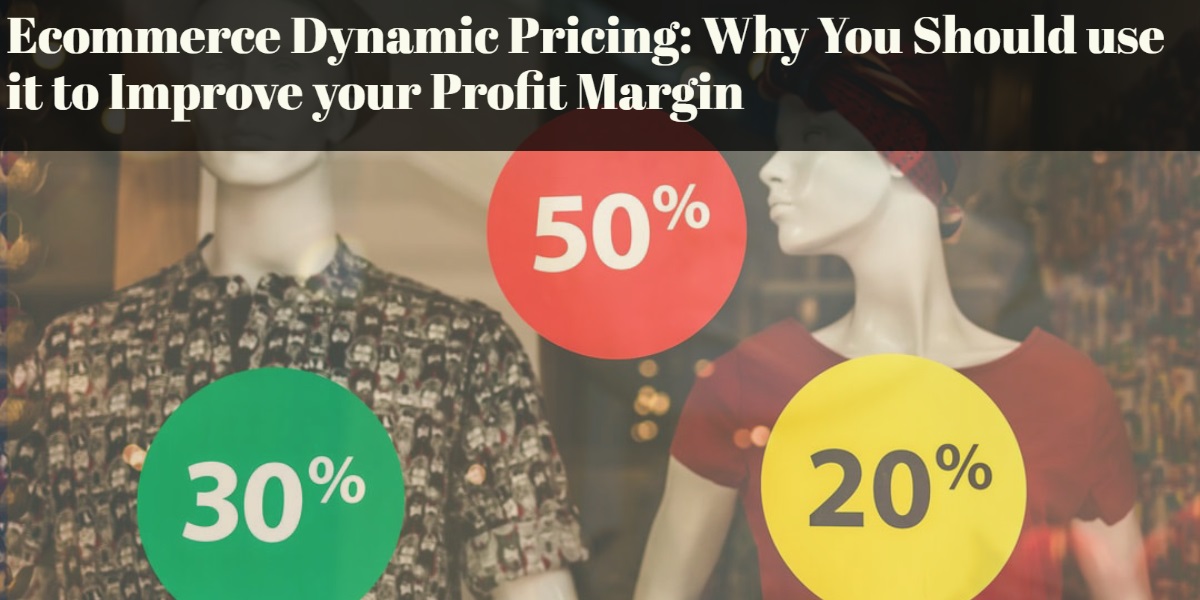Ecommerce Dynamic Pricing: Why You Should use it to Improve your Profit Margin

 5mins Read
5mins Read
In the competitive world of e-commerce, a poorly planned pricing strategy can cause major problems for your Online Store. When you price your product too high, no one will be able to afford it; price it too low, and your profit margin goes down the drain.
The point is your pricing strategy has a major impact on the success of your e-commerce business experiences. At first, it could affect your customers’ purchasing decision and on the other hand, it could affect the bottom line of your business.
Before we go into the details on how to use dynamic pricing on your online store, let us have a look at the meaning of dynamic pricing.
What is Dynamic Pricing?
According to seasoned experts, Dynamic pricing is a responsive pricing strategy whereby businesses make the cost of their goods or services flexible based on market demands and factors.
Factors like
- Industry standards: Industry-wide average pricing; pricing ranges; most common prices amongst competitors
- Market conditions: Past, current, and future supply and demand; Consumer purchasing patterns/habits (both yours and your industry’s)
- Consumer expectations: How much your customers are happy to pay and how much they are willing to pay; How much they expect to pay
Dynamic pricing dates back over 30 years to an American Airlines promotion that saw a surge in prices during high-demand periods for air travel.
Since then, dynamic pricing has slowly crept into the retail sector. Today, e-commerce is finally moving toward dynamic pricing solutions to get the most out of every sale. Essentially, a dynamic pricing model is one that increases prices to maximize profits during high demand “boom” periods and reduces prices to increase sales during slow seasons.
It all comes down to robust automation with a human touch at just the right moments. Dynamic pricing requires that you collect a lot of information about your industry, your competition, and your customers.
Needless to say, collecting, organizing, and storing this data is a task better suited for a computer; however, it’s up to your team to define what data they’re looking for, which pieces of information are most important or valuable, and how each data point should impact your products’ pricing. Also, while dynamic pricing tools are made to suggest optimal prices for your products based on all of this data, such a vital moment again requires a hands-on approach from your team.
At any rate, the process of dynamically pricing a single item involves many touch-points by machine and by a human. However, not everyone’s exact process will look the same.
Why Adopt Dynamic Pricing?
There are many reasons why a grow-oriented e-commerce retailer might want to adopt dynamic pricing, starting with market insights.
Dynamic pricing software for e-commerce retailers analyzes massive amounts of data in real-time to determine whether a product is in high or low demand and whether a price adjustment will result in an uptick in sales. The service provider, who then uses this data to optimize prices more intelligently in the future, then stores data.
In other words, dynamic pricing sets up a positive feedback loop in which price adjustments create sales data, which is analyzed to create even better market data in the future. The result is a boost in sales that would not otherwise occur with static, non-responsive pricing.
Dynamic Pricing: Case Studies
Let us consider the rapid success of Amazon, an online retailer that adjusts their prices roughly six times per hour to reflect fluctuations in supply and demand. Their massive year-over-year growth has led to other retailers, such as Target, Kohl’s and Walmart also adopting price optimization strategies on their online and mobile stores.
After adopting dynamic pricing in 2013, Walmart saw worldwide online sales growth above 30 percent, with comparable growth (+28%) the following year. This should come as no surprise, as recent research has suggested that dynamic pricing responsive to “add to cart” user functions can pad gross margins by as much as 10 percent.
Similarly, Best Buy also bolstered its online shopping experience with dynamic pricing in 2013 and saw growth on par with Walmart’s (+27.2% sales volume). The success of Walmart and Best Buy goes to show how dynamic pricing mechanisms can help entice shoppers to commit to an online purchase without abandoning their cart.
Price Optimization
Many of the leading e-commerce platforms have built-in dynamic pricing capabilities. However, they do not always resemble each other. At present, e-commerce stores are leaning four main price optimization methods on to increase sales:
- Peak pricing
- Penetration pricing
- Segmented pricing
- Service time
Ultimately, the type of e-commerce business you own will largely determine the pricing strategy you employ.
Peak User Pricing
In the transportation industry, peak user pricing has been the prevailing dynamic pricing strategy for decades. Under this model, users pay a premium during periods where demand is at its highest—for instance, For Air travel during the Christmas season or at a closing time during a night out on the weekends for taxi rides.
eCommerce stores that have limited inventory can benefit from peak user pricing by taking advantage of the inelasticity of demand. In other words, you can charge more on every sale simply because the customer is willing to pay more for the service or product.
Penetration Pricing
If you want to introduce a new product to your customers, but are unsure how successful it may be, consider leveraging the power of penetration pricing to draw them to your e-commerce store and away from your competitors’. Under this model, a new product is initially sold under market value to gauge its popularity, and then the price is adjusted to match its true market value.
Segmented Pricing
Not everyone is willing to pay the same amount for the same product. For this reason, e-commerce stores can boost their sales by implementing a segmented, or “tiered” pricing strategy to capture as much of the market as possible.
This pricing strategy sees multiple tiers from “Value” to “Premium Plus” so that consumers with different budgets can access their product. Take, for instance, the Xbox One (base model) versus Xbox One S (upgraded) and the Xbox One X (premium version), which are priced roughly $100 apart from each other, respectively.
Service Time
Many e-commerce businesses charge more for faster services. For instance, same-day service or one-day delivery can and should result in a premium service charge. This way, you can maximize profits by capitalizing on the increased demand for a higher-quality product or service from a segment of your customer base.
Conclusion
The e-commerce industry is rapidly expanding, and vendors need to go the extra mile to maintain their competitiveness in this ever-changing market. Dynamic pricing and pricing intelligence software can be used to boost sales, increase customer satisfaction, and maximize profits.
To stand out among the competition, your ultimate goal as you implement dynamic pricing should be to continue learning as much as you can about your industry, your competitors, and your customers, and to stay focused on what all this information means for your products’ prices.




















 TrustGuard - PCI Security Scanner
TrustGuard - PCI Security Scanner
